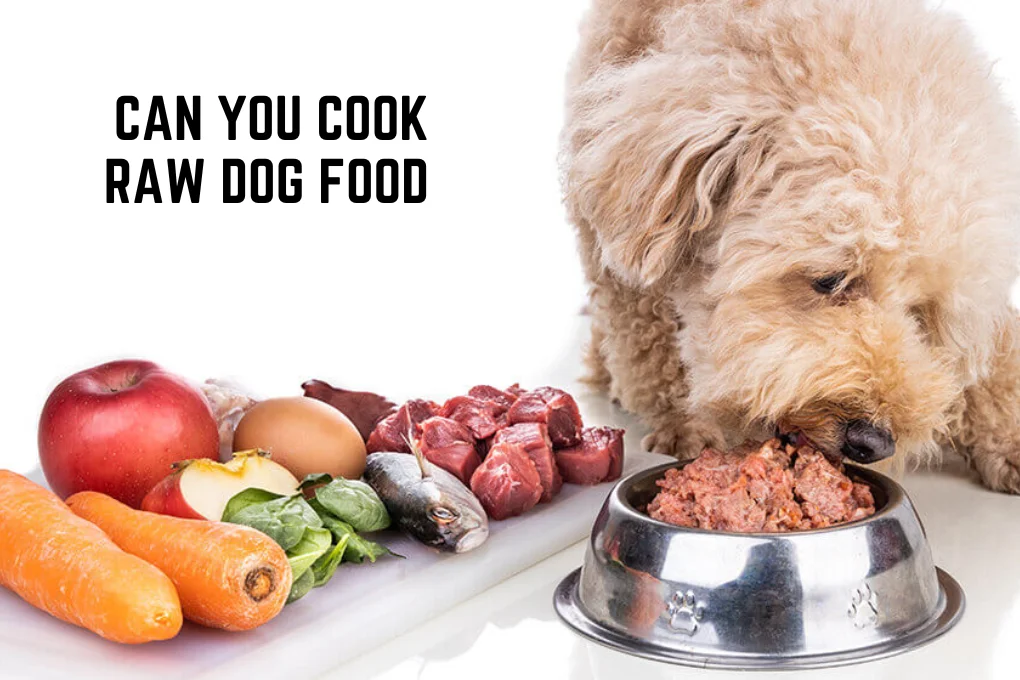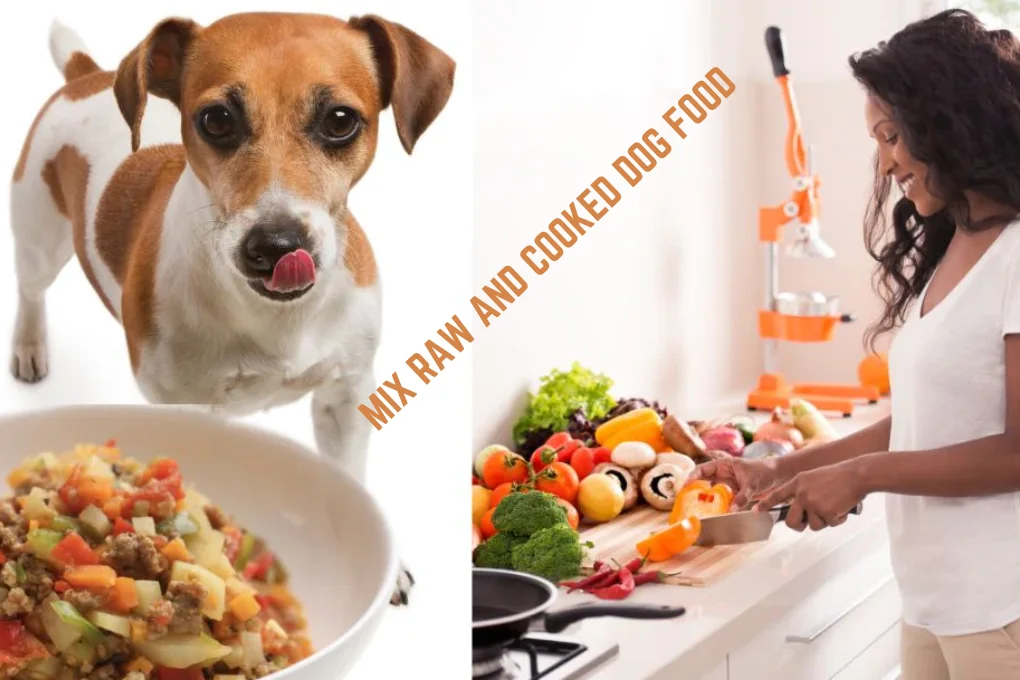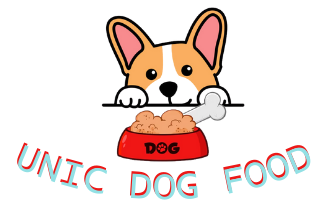This question I’ve often been asked, “Can you cook raw dog food?” As a passionate pet owner, I’ve explored the world of canine nutrition extensively.
Yes, you can cook raw dog food, although it might seem a bit contradictory since “raw dog food” typically refers to a diet of uncooked ingredients.
However, some dog owners choose to prepare homemade raw dog food and may lightly cook some of the ingredients for various reasons, such as food safety or to make the food more digestible for their pets.
In this post, I’ll share my insights on preparing raw dog food at home, addressing common concerns, and providing a simple guide to get started.
Can you cook raw dog food?
Yes, you can cook raw dog food, but doing so would make it not truly “raw” anymore. Raw dog food is typically made from uncooked, natural ingredients like raw meat, bones, and vegetables.
The idea behind feeding dogs raw food is to provide them with a diet that closely resembles what their wild ancestors might have eaten.
Raw dog food advocates believe it can have various health benefits for dogs.
If you choose to cook your dog’s food, you should be aware that cooking can alter the nutritional content of the ingredients. Some nutrients may be lost or become less bioavailable during the cooking process.
So, suppose you’re interested in providing your dog with a cooked diet. In that case, it’s a good idea to consult with a veterinarian or a veterinary nutritionist to ensure your food is nutritionally balanced and meets your dog’s specific dietary needs.

Cooking can also eliminate potential pathogens, such as bacteria or parasites, present in raw meat, which can be a concern when feeding a completely raw diet.
So, cooking can be a safer option to reduce your dog’s foodborne illness. If you choose to cook raw dog food, it’s important to consider the following:
Food Safety
Cooking can help eliminate potential pathogens like bacteria, which may be present in raw meat.
This is especially important if you’re concerned about the risk of foodborne illness for your dog or if your dog has a weakened immune system.
Digestibility
Lightly cooking certain ingredients can make them easier for some dogs to digest. For example, lightly cooking vegetables can help break down cell walls, making the nutrients more accessible.
Vet Consultation
It’s always a good idea to consult a veterinarian or a canine nutritionist before significantly changing your dog’s diet.
They can help you create a balanced and safe homemade dog food recipe tailored to your dog’s needs.
Ingredients
Raw dog food typically includes raw meat, bones, organs, vegetables, and fruits.
If you choose to cook the meat, be cautious about cooking bones, as they can splinter and become dangerous for your dog. Cooking may also destroy some beneficial enzymes and nutrients in raw food.
Balance
It’s essential to ensure that your dog’s diet is balanced and meets their nutritional requirements. Whether raw or cooked, homemade diets can be challenging to get right without professional guidance.
Supplements
You may need to add supplements to ensure your dog gets all the necessary nutrients, as cooking can reduce the nutritional value of some ingredients.
If you decide to cook your dog’s food, follow a well-researched recipe that balances protein, fats, carbohydrates, and essential vitamins and minerals.
The exact recipe will depend on your dog’s age, size, activity level, and health considerations. Always monitor your dog’s health and consult your veterinarian for guidance.
Cooking Raw Dog Food: Is It Possible?
While the idea of cooking raw dog food might seem contradictory, it is entirely feasible. Many dog owners opt for a partially cooked approach as a way to balance the benefits of a raw diet with the safety of cooked food.
Cooking raw dog food can help reduce the risk of foodborne illnesses for both your dog and your family.
By cooking raw dog food, you can potentially reduce the risk of bacterial contamination, making it a more comfortable choice for those concerned about safety.
However, balancing cooking and preserving the essential nutrients a raw diet aims to provide is essential.
Are There No Added Benefits in Cooking Raw Dog Food?
Cooking raw dog food can have some added benefits.
• Pathogen Reduction: Cooking kills harmful bacteria, making it safer for your dog.
• Nutrient Availability: Heat can make certain nutrients more digestible.
• Customisation: Cooking lets you tailor the food to your dog’s specific needs.
• Variety: Cooked food can offer different tastes and textures.
• Digestibility: Some dogs find cooked food easier to digest.
• Reduced Risk: Cooking reduces the risk of foodborne illnesses.
• Convenience: Cooking might be easier for some dog owners.
Can You Mix Raw and Cooked Dog Food?
Certainly, you can mix raw and cooked dog food, but some important factors must be considered.
I’ve done this for my own furry friend, and it can provide a balanced and nutritious diet. Here’s what you need to know:
Balanced Nutrition
Combining raw and cooked dog food can provide your canine companion with a more balanced and varied diet.
Raw food may include fresh meats, bones, and vegetables, while cooked food can consist of lean meats, rice, and certain vegetables. This variety can help ensure your dog gets a wide range of nutrients.
Food Safety
When mixing raw and cooked dog food, paying extra attention to food safety is vital. Keep raw and cooked ingredients separate to prevent cross-contamination.
Clean utensils, bowls, and surfaces thoroughly after handling raw ingredients. Always store raw food properly and ensure it’s fresh to reduce the risk of bacterial contamination.

Portion Control
Be mindful of portion sizes when mixing these foods. You should adjust the raw and cooked ingredients’ proportions based on your dog’s nutritional requirements, size, and activity level. Consult with your veterinarian to determine the right balance.
Digestibility
Some dogs may have sensitivities to certain ingredients, whether raw or cooked. When introducing a mixed diet, monitor your dog’s digestion and overall well-being.
Consider adjusting the ingredients or proportions if you notice any adverse reactions or digestive issues.
Consult Your Vet
Before making any significant changes to your dog’s diet, it’s wise to consult with a veterinarian. They can guide the best mix of raw and cooked food and offer recommendations tailored to your dog’s needs.
Complete and Balanced Diet
Ensure that the combination of raw and cooked ingredients you provide meets your dog’s nutritional requirements.
You can also consider commercial dog food designed to be a complete and balanced meal and then supplement it with raw or cooked ingredients as treats or additions.
Final Thoughts
In conclusion, can you cook raw dog food? Well, yes, you can! 🍳🐶 But here’s the deal: Cooking it kinda takes the “raw” out of the equation.
While cooking can kill nasty germs and make nutrients more accessible, you may lose some of that wild, natural flair. 🐾 Cooking your dog’s food can be pretty convenient, and some pups might find it easier to stomach. 👩🍳👨🍳 But remember, balance is key. 🥦🍗
Talk to a vet or nutritionist to whip up a paw-some recipe that suits your furry friend’s needs. So, whether you go raw or cooked, just keep your dog’s tail wagging and their tummy happy! 🐕❤️
- Homemade Bone Broth For Dog Recipe - December 17, 2025
- Can You Cook Raw Dog Food? - September 10, 2025
- Homemade No-Bake Dog Treat Recipes Your Pup Will Love - September 6, 2025
